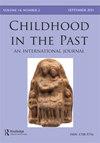编辑
IF 0.5
Q3 ANTHROPOLOGY
引用次数: 0
摘要
欢迎收看过去的童年研究学会(SSCIP)期刊《过去的童年》第16卷第2部分。本期包括两篇研究论文和三篇书评,以及马克·戈尔登(1948年8月6日至2020年4月9日)的讣告,他是该杂志SSCIP委员会和编辑委员会的成员。在第一篇研究论文中,Sally Waite和Emma Gooch探讨了公元前五世纪雅典彩陶缺乏母性表现的原因。他们注意到,在古代雅典社会中,生产和照顾孩子是妇女的关键角色,还有其他证据表明,妇女与婴儿之间的联系特别紧密。他们回顾了彩陶中的儿童保育图像,试图评估妇女和婴儿在私人和公共生活领域的特征。他们将母亲形象的匮乏解释为五世纪雅典社会父权制背景下对母亲身份的贬低、妖魔化和挪用的证据,并讨论了作为一种制度的母亲身份和作为一种体验的母亲身份之间的脱节。Lynne McKerr和我的第二篇论文探讨了爱尔兰北部阿尔斯特17世纪和18世纪坟墓纪念馆中儿童的社会知名度。包括的纪念物代表了17世纪初阿尔斯特种植园期间来到该地区的盖尔爱尔兰人以及以新教为主的定居者。在种植园之后发生的重大经济和文化变化之后,对其纪念坟墓纪念碑的频率和外观进行了探索,以研究儿童纪念碑如何表明其家人希望表达的宗教、社会和/或种族身份。它还调查了在这种紧张的社会政治环境中,独特的家庭情节如何使盖尔爱尔兰人能够维持他们复杂的亲属关系,并成为定居者家庭建立或加强其社交网络的手段。我们还探讨了侵占高地位的本土墓地可能是一种控制手段和征服的有力象征。该杂志以Siân Halcrow编辑的书评集结尾——Rose a.Sawyer的《中世纪的变化:健康、儿童保育和家庭单元》;Anne L.Grauer主编的《劳特利奇古病理学手册》和Michael Obladen主编的《牛津新生儿教科书:文化和医学史》。一如既往,衷心感谢所有对我们期刊的成功至关重要的撰稿人和审稿人。本文章由计算机程序翻译,如有差异,请以英文原文为准。
Editorial
Welcome to Part 2 of Volume 16 of Childhood in the Past, the journal of the Society for the Study of Childhood in the Past (SSCIP). This issue comprises two research papers and three book reviews as well as an obituary for Mark Golden (6 August 1948–9 April 2020), who was a member of the SSCIP Committee and Editorial Board for the journal. In the first of the research papers, Sally Waite and Emma Gooch explore the reasons for the lack of representation of motherhood on Athenian painted pottery from the fifth century BC. They note how the production and care of children was a key role for woman in ancient Athenian society and that other evidence exists which demonstrates the particularly close bonds that women had with their infants. They review images of childcare in painted pottery in an attempt to assess how women and infants are characterised in both the private and public spheres of life. They interpret the paucity of images of motherhood as evidence of the devaluation, demonisation and appropriation of mothering within the context of the patriarchal nature of fifth century Athenian society and discuss the disconnect between motherhood as an institution and mothering as an experience. The second paper by Lynne McKerr and I explores the social visibility of children in 17th and 18th century grave memorials from Ulster in the north of Ireland. The memorials included represent those of the Gaelic Irish as well as the largely Protestant settlers who came to the region during the Plantation of Ulster in the early 17th century. The frequencies and appearance of their commemorative grave memorials are explored to examine how children’s memorials may signify the religious, social and/or ethnic identity their families wished to express, in the aftermath of the major economic and cultural changes which followed the Plantation. It also investigates how, within this tense socio-political environment, distinctive familial plots may have enabled the Gaelic Irish to maintain their complex kin relationships and also been a means for settler families to establish or strengthen their social networks. We also explore how the appropriation of high status native burial grounds may have been a means of control and a powerful symbol of subjugation. The journal ends with a collection of book reviews edited by Siân Halcrow – The Medieval Changeling: Health, Childcare, and the Family Unit, by Rose A. Sawyer; The Routledge Handbook of Paleopathology, edited by Anne L. Grauer and the Oxford Textbook of the Newborn: A Cultural and Medical History, by Michael Obladen. As always, sincere thanks are due to all the contributors and reviewers who are so essential to the success of our journal.
求助全文
通过发布文献求助,成功后即可免费获取论文全文。
去求助
来源期刊

Childhood in the Past
Social Sciences-Anthropology
CiteScore
0.90
自引率
0.00%
发文量
16
期刊介绍:
Childhood in the Past provides a peer-reviewed, interdisciplinary, international forum for the publication of research into all aspects of children and childhood in the past, which transcends conventional intellectual, disciplinary, geographical and chronological boundaries. The editor welcomes offers of papers from any field of study which can further knowledge and understanding of the nature and experience of childhood in the past.
 求助内容:
求助内容: 应助结果提醒方式:
应助结果提醒方式:


